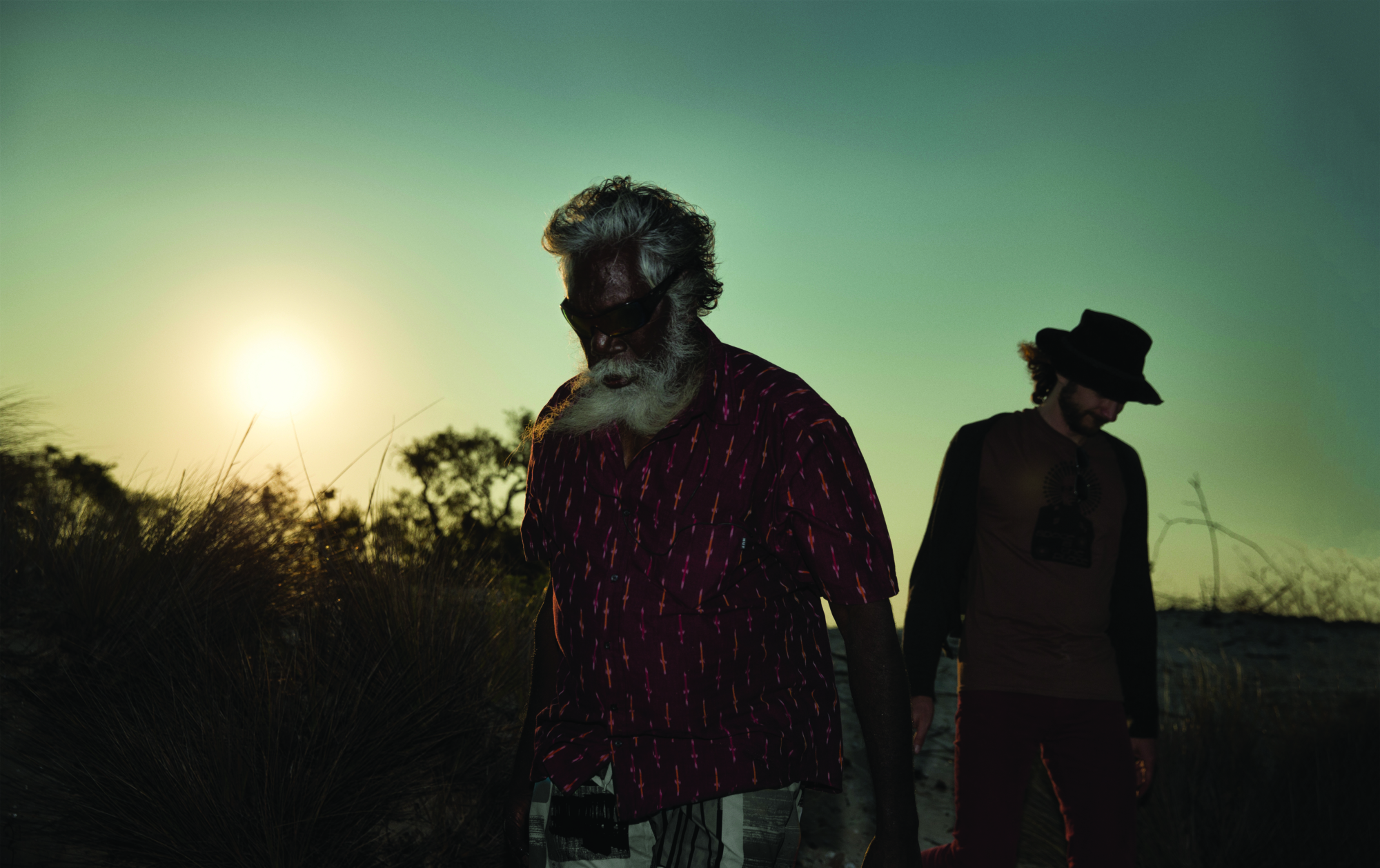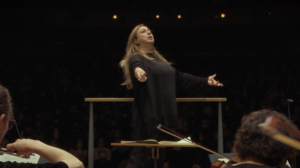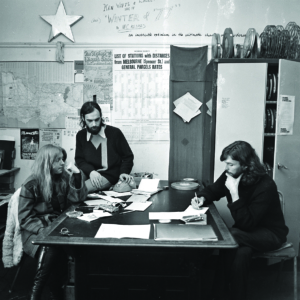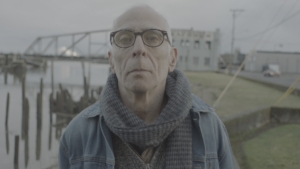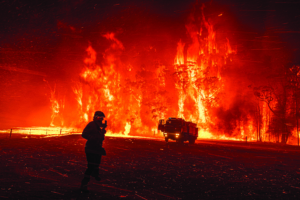‘An ancient story was handed down to me. This is the truth. When you feel it sinking into you, then you will know.’
A Yolngu senior law man and father, Djalu Gurruwiwi is one of the last living leaders of his people’s country in the Northern Territory. His words open Westwind: Djalu’s Legacy (2017) – by director/co-writer/co-producer Ben Strunin – in subtitles as lightning cracks over blue storm clouds in fast motion. A master yidaki (didjeridu) player, Djalu is not just a songman but a custodian of the Galpu clan’s songlines. He knows his time in this world is almost up, however, and his son Larry Larrtjanŋa Gurruwiwi[1]Larry is also credited as one of the script’s writers. and the youth of their community have not yet worked out how to sustain their culture and country.
A production for the Melbourne International Film Festival Premiere Fund and NITV, Westwind is the story of how an Indigenous elder united with a global pop star – Australian Wally De Backer, better known as Gotye – to save an ancient culture, culminating with a performance by his son’s band, Bärra West Wind, at the festival WOMADelaide in 2015. Beyond that, the documentary offers a lesson in the tradition of songlines for a broader, non-Indigenous audience unacquainted with Aboriginal law, and a lucid vision of how Indigenous cultures are engaging new technologies to ensure their survival today.
Nobody really knows how old Djalu is; he was born before his people measured time in the Western way. He speaks of how, in the Dreaming, the sound of the Westwind travelled and carried the song of the rainbow serpent on its journey. Through voiceover, we learn that the songs that Djalu and his people sing today are not just melodies, but forms of sacred cultural knowledge and practical information combined – a special way of keeping valuable intelligence, tracing the footsteps of ancestors, telling where to find food and shelter. But a songline is not just utilitarian, like a map – if a song dies, the information it contains also dies, along with its spirit. We also learn that songlines address the land’s trauma, the ecological destruction wrought by colonisation; by singing, says Larry, ‘You heal the land, because the land needs us.’ And they are spiritual: our narrator, Mungul, tells us that ‘songlines, for us, are more than sounds – we also use them to talk to our ancestors.’
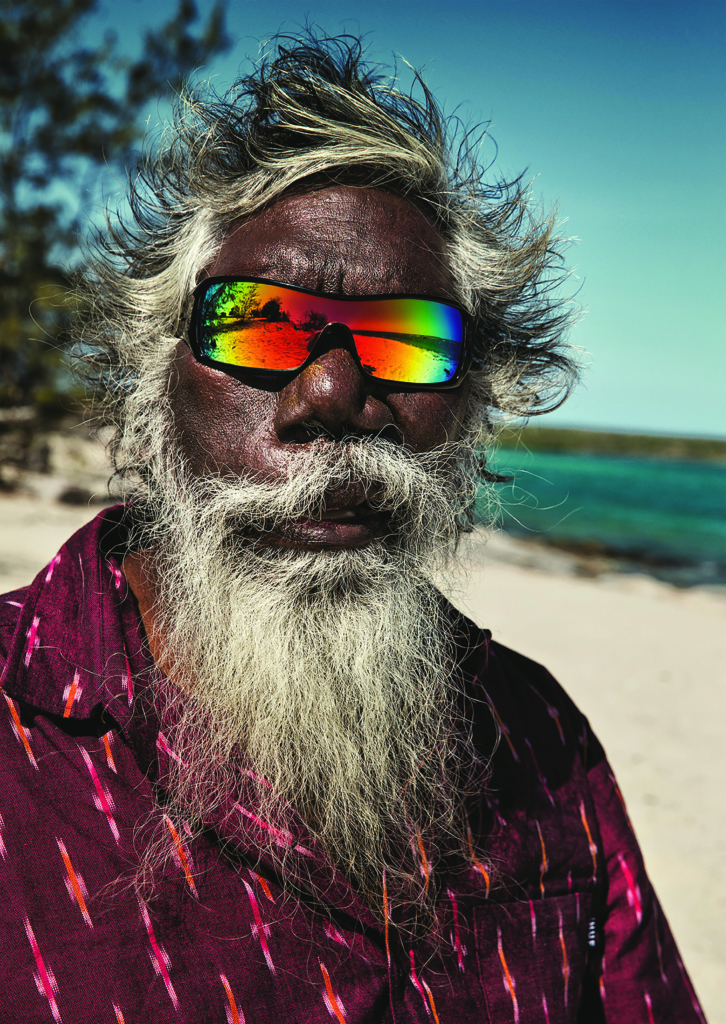
Gotye’s single ‘Somebody That I Used to Know’, recorded with New Zealand singer Kimbra, has over a billion views on YouTube to date. He is a balanda – a non-Indigenous person of European descent – and unrecognised by Djalu as a famous musician. The elder sees something different: Gotye and his friends are another opportunity to extend the life and resonance of songlines. For Djalu, blood line isn’t everything. He has no qualms about inviting Gotye into his world: sharing his culture across the world keeps it alive.
‘Aunty’ Gurruwiwi, Djalu’s sister, says that Galpu ceremony hasn’t been happening, blaming it on ‘distractions’ such as ‘alcohol, drugs, the technology that is here now. You [young people] are going the different direction, not on the path of knowing who you are and where you come from.’ A scene with Djalu and community youth shows the problem: under a great tree, he tries to teach them yidaki, but the boys are talking among themselves, smoking weed, showing disrespect. ‘What is your future?’ admonishes Djalu. ‘Without this’ – their culture and connection to Indigenous tradition – ‘you have nothing.’ This is where the film’s arc comes into view: it seeks to chronicle the search for a new custodian of the yidaki to carry the Westwind, to ‘take over the ceremony and lead the people’ before Djalu dies.
Larry is a reluctant inheritor for the very reasons that Aunty speaks of. A former footballer, he has strayed into alcoholism and survived a suicide attempt. He speaks plainly about the tenuousness of his connections to Indigenous culture and law: ‘Maybe I’m different,’ he says. ‘In my life, there’s someone talking to me: “Why don’t you go this way?” Big trouble every day. I hanged myself when I was drinking. Cord broke down.’ Djalu says of his son: ‘He was always lonely. I grew up the same as Larry, but always I followed my father.’ Paul ‘Ahva’ Hayes, a musican and sound engineer, recounts: ‘When I first met Larry, he was withdrawn.’ Larry describes coming back to his culture through the process of writing music in his own language: ‘I heard the voice in myself. It was a good voice.’ His wife, Leanna, attests to the transformation.
Gotye and his friends are another opportunity to extend the life and resonance of songlines. For Djalu, blood line isn’t everything. He has no qualms about inviting Gotye into his world: sharing his culture across the world keeps it alive.
By chronicling Larry’s struggles, Westwind gently points to the larger breakdown of the structures of Indigenous society, and their replacement with a profound and intangible alienation and dysfunction – to what happens when connection to country and culture is replaced by uncertainty. But the documentary’s real strength is the way it explores these questions as they manifest in forms of personal and spiritual crisis – that is, in terms of generational change and Larry’s negotiation of his identity and community – rather than by connecting them explicitly to policy, as would a film positioned more squarely in the social-issues documentary genre.
The real focus is different Indigenous peoples’ relationships to their law as it continues to be impacted by balanda society. ‘Balanda people, they come on horses and they gone lynching, gone shooting, and bad things happening,’ says Djalu, of invasion. ‘Different mind, different tongue.’ His daughter Zelda chimes in:
The role of our law men and women is harder now. Balanda law always changes, and [Indigenous] law is always there. Balanda law can come together with [Indigenous] law, but that isn’t happening.
Aunty says that her clan needs someone with the right sensibility to assume her brother’s role: ‘To gain that insight, you have to see the unseen: things that you come to realise within your spirit, in the spiritual realm.’ Djalu describes it like this: ‘Things which are invisible – it is knowledge that can’t be seen out there. The right person has the ability to see the unseen.’
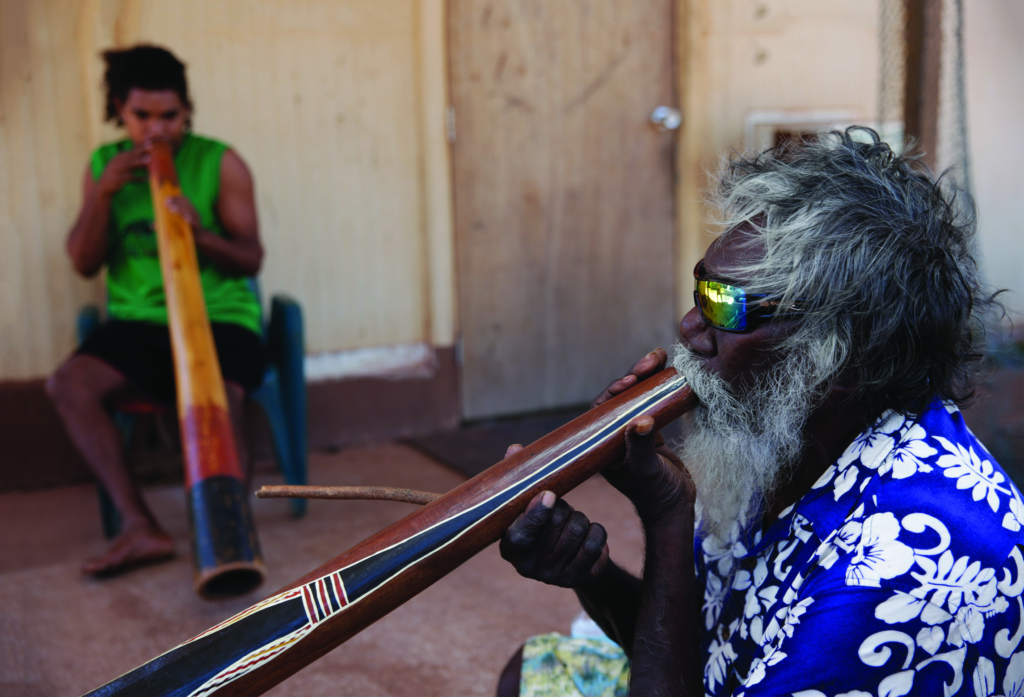
In these laconic sentences, we grasp the impossibility of conveying in words, let alone words in the English language, the breadth and knowledge of a culture that has been there since the beginning. How does one craft a low-budget documentary about such expansive subject matter? How does one imagine in cinematic form – in an art born of Western industrial models and modernist technology – things that the Western mindset cannot dream of? The law and culture that Djalu and his family allude to hinges on non-verbal forms of knowledge: making yidaki, connecting to one another and to ancestral spirits through melody and rhythm, practising communal ways of living and working together, dancing at ceremony, painting the body with the colours and dots and lines of ancestors – even just being together on country. But finding a cinematic language that is more aural and visual than verbal is not a challenge that the project’s filmmakers have deeply invested in. For a project about song and sound, Westwind is not an innately musical film; rather, it adopts the televisual and journalistic conventions – talking heads, subtitles, an observational style – of much Australian documentary making enabled by broadcast television’s production and distribution infrastructures.
But a scene early in the film suggests that documentary cinema may be able to find new forms and conventions to meet these themes. In the bush, Djalu shows us how he makes the yidaki, and we get a shot from a camera attached to a tree as it’s felled – the camera looking and moving from the tree’s viewpoint (or perhaps the tree’s spirit’s viewpoint) as it arcs towards the ground. Having film form capture ecological aesthetics: this is an exciting possibility that is only glanced at by the filmmakers (it is not a consistent visual storytelling strategy employed throughout the film). Likewise, drone cinematography, now a mainstay of documentary making, captures a sense of loftiness that matches Djalu’s words, with wide shots that hover over country, over mangroves and marshland at the height of the outspread clouds that bring down fresh water and start new seasons of life. In these moments, we understand what it might mean for contemporary documentary to function as a channel for magnifying Indigenous law: not as a fuzzy and amorphous artefact, as mainstream Australia often imagines it, but as a functioning system of agreed-on practices that constitute a society.
We understand what it might mean for contemporary documentary to function as a channel for magnifying Indigenous law: not as a fuzzy and amorphous artefact, as mainstream Australia often imagines it, but as a functioning system of agreed-on practices that constitute a society.
The film’s optimistic narrative arc isn’t always clear about the practical ways in which Djalu’s, Larry’s and Gotye’s combined efforts have or haven’t salvaged ancient songlines. Has, for instance, the Galpu clan resumed regular ceremony and other law practices? Has Larry permanently assumed his father’s place as a law man and yidaki keeper? Instead, Strunin’s film branches outwards to tap into other, impactful resonances: the distribution of Bärra West Wind’s debut album, community screenings of Westwind on country, special screenings in cities with talks and cultural education cushioned around the film, distribution to different publics at festivals and on broadcast television. By spotlighting an Indigenous elder and presenting information about his people’s law to a broad audience, the documentary’s educational aims are self-evident – and it is to the filmmakers’ credit that the celebrity figure of Gotye is not introduced until Djalu and his community’s story is well established.
Facilitating Bärra West Wind’s recordings and performance with Gotye is another of the documentary’s firm outcomes. The pop star identifies his motivation as getting ‘a new perspective on things I thought were familiar. I can’t say I’ve listened to a didjeridu outside of some Western, urban context’, adding that what he gains from his interactions with Larry and Djalu is ‘a glimpse of something really deep and broad. I need to ask more questions, I think.’ He works on learning how to make a yidaki: how to identify the right trees from which to build them; how to strip the bark, hollow the trunk, and render it smooth and long; how to get the right texture and tone in the sound; how to continue the breath through each burst of vibration. Djalu’s mastery and respect for the trees and the yidaki are evident in the economy and efficiency of his movements – four chops and the tree is felled. Within minutes, the songman is skilfully playing the tree: transformed, it is now a plant and instrument in one.
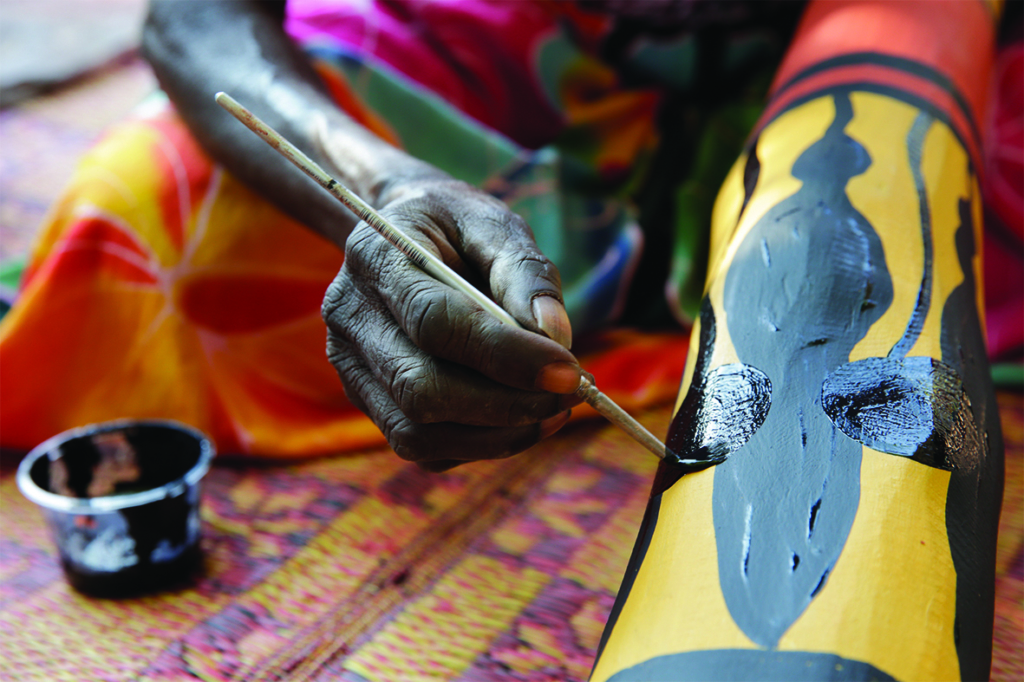
According to Gotye, Larry is ‘trying to synthesise a contemporary style [with songlines]’, describing father and son as ‘pretty different people – they have different ideas about the world, but Larry really understands Djalu’. Larry interjects:
‘My culture is changing to the music. For my old man, it’s the songlines. For me, it’s the band.’ Later, Gotye records Djalu playing his yidaki on a stormy night on an Arnhem Land beach; it’s a moment in which modern sound engineering captures an ancient songline: ‘The lightning, I can sing it.’ To think and speak of singing the lightning is to conflate things in categories that the colonising culture sees as distinct. ‘Leave the water, drenched in rainbow light,’ Djalu sings.
‘There’s so much you can bring to the act of listening,’ Gotye reflects. ‘I have to actively try to stop my overactive brain.’ The songwriting process with Larry teaches Gotye to trade analysing for listening in a holistic, feeling, intuitive sort of way. ‘I want to clear my mind, because it seems that things are more clear here [on Galpu land]; they have a certain rhythm.’ Working towards the WOMADelaide performance with Larry, he begins to question what music festivals can do: ‘Festivals are a real chance to think, “This is us – these are our stories,” but we want people in the audience to hear our story and make a new story together.’
The songs Larry and Gotye play at the festival are made of anthemic, spacious sounds and surrounded by reverb. The band calls out, ‘We will be with you—’ and Gotye finishes the line, ‘—when you’re leaving’. The rest of the time, he sings in harmony with Larry in the lead. Bärra West Wind’s songs, like those of Yothu Yindi, are reminders that much Indigenous music is dance music – sounds to move to, sounds for ceremony – and they translate organically to a festival environment, where many bodies move in communion.
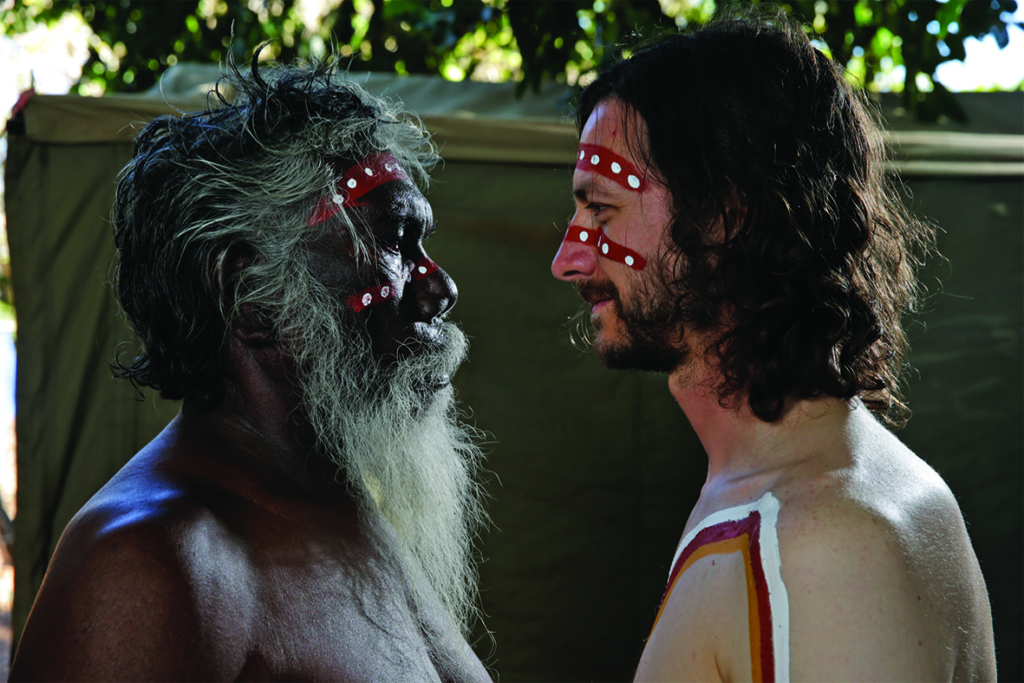
In showing how Djalu and Larry adapt to the weight of balanda life, Westwind: Djalu’s Legacy taps into the shifts and ruptures between different generations of Aboriginal people, and traces the changes in the songman’s journey from Djalu’s time – almost past – to Larry’s time in the late-capitalist present. The documentary doesn’t, however, climax with the WOMADelaide performance, but with a traditional ceremony led by Djalu on the beach, under clouds and lightning, in his Galpu homeland. This is a narrative arc that feels true to the film’s Indigenous themes. ‘This is the sound of the people,’ sings Djalu. ‘This is our journey. This is our path. We cry for our lands. I’m telling you the story – not from here, head, but from here, heart. The Westwind still travels.’
http://www.westwindthefilm.com
Endnotes
| 1 | Larry is also credited as one of the script’s writers. |
|---|
